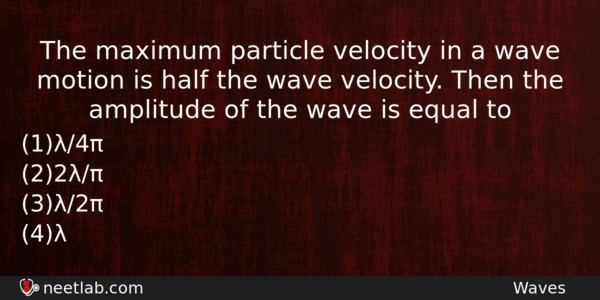| ⇦ | 
| ⇨ |
The maximum particle velocity in a wave motion is half the wave velocity. Then the amplitude of the wave is equal to
Options
(a) λ/4π
(b) 2λ/π
(c) λ/2π
(d) λ
Correct Answer:
λ/4π
Explanation:
For a wave, y = a sin [(2πvt/λ) – (2πx/λ)]
Here v = velocity of wave
.·. y = a sin [(2πvt/λ) – (2πx/λ)]
dy/dt = a (2πv/λ) cos [(2πvt/λ) – (2πx/λ)]
velocity = (2πav/λ) cos [(2πvt/λ) – (2πx/λ)]
Maximum velocity is obtained when
cos [(2πvt/λ) – (2πx/λ)] = 1
.·. v = (2πav/λ)
Then, v = v/2
(2πav/λ) = v/2 or a = λ/4π.
Related Questions: - Laser light is considered to be coherant because it consists of
- A force of 10N is applied on a body for 3 sec and the corresponding displacement 6 m.
- Reactance of a capacitor of capacitance C µF for A.C freqency (400 / π) Hz is 25 ohm
- A satellite of mass m revolves around the earth of radius R at a height x from
- A pure semiconductor behaves slightly as a conductor at
Topics: Waves
(80)
Subject: Physics
(2479)
Important MCQs Based on Medical Entrance Examinations To Improve Your NEET Score
- Laser light is considered to be coherant because it consists of
- A force of 10N is applied on a body for 3 sec and the corresponding displacement 6 m.
- Reactance of a capacitor of capacitance C µF for A.C freqency (400 / π) Hz is 25 ohm
- A satellite of mass m revolves around the earth of radius R at a height x from
- A pure semiconductor behaves slightly as a conductor at
Topics: Waves (80)
Subject: Physics (2479)
Important MCQs Based on Medical Entrance Examinations To Improve Your NEET Score
18000+ students are using NEETLab to improve their score. What about you?
Solve Previous Year MCQs, Mock Tests, Topicwise Practice Tests, Identify Weak Topics, Formula Flash cards and much more is available in NEETLab Android App to improve your NEET score.
Share this page with your friends

Since max. Particle velocity= aω
Wave velocity = ω/k
Acc to que
aω = 1/2 (ω/k)
Solving ,
a = 1/2k
Since k= 2π/ λ
Hence a = λ/4π